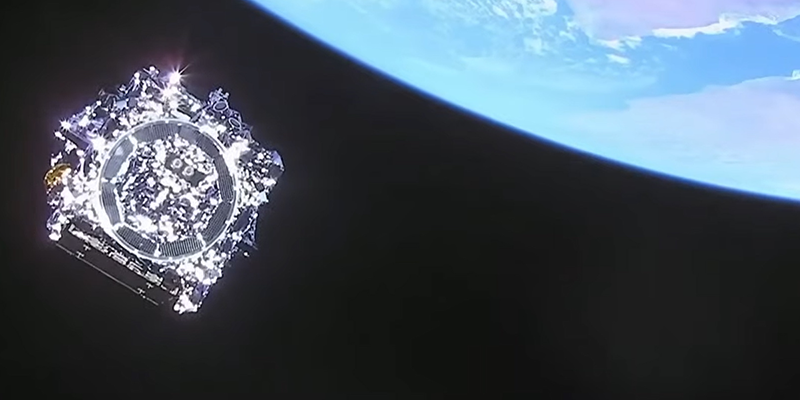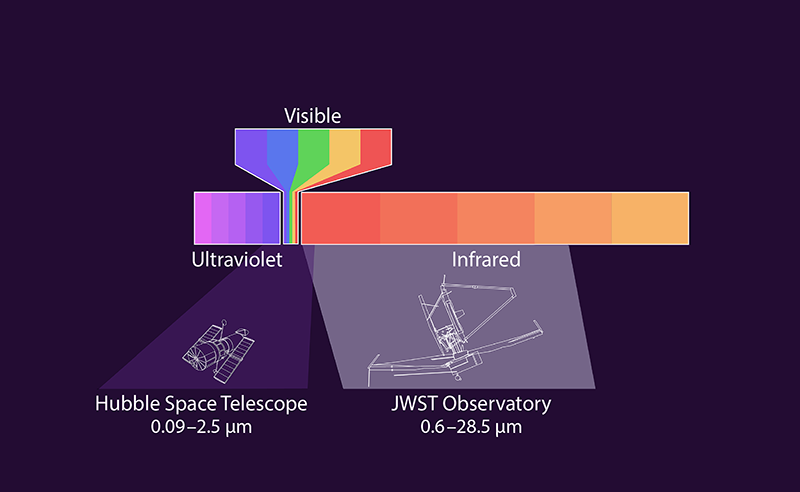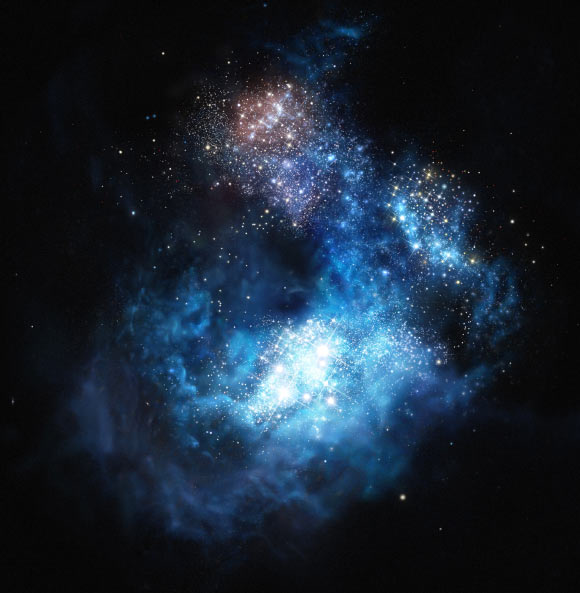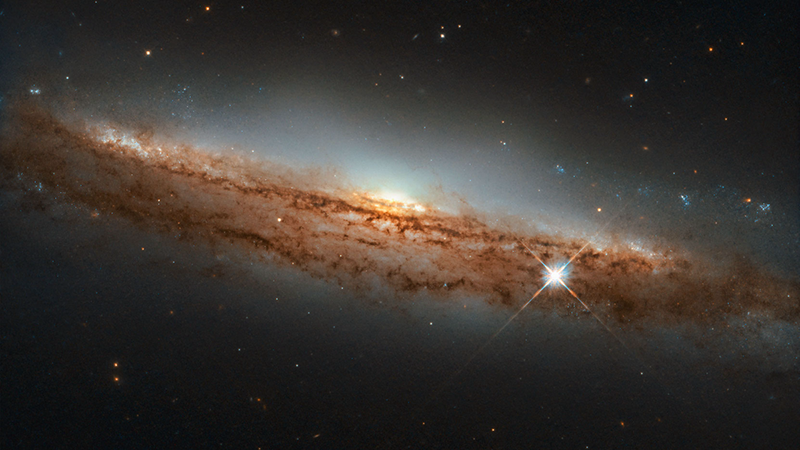JWST Sees More Galaxies than Expected
Two weeks after NASA revealed the first images taken by the JWST observatory, scientists woke to the news that cosmology might be broken. Analyzing the JWST’s images, a team of astronomers had spotted a galaxy that shouldn’t be there, at least according to the most frequently used model of the Universe’s evolution, called ΛCDM [1]. The galaxy was inexplicably bright and incredibly young with respect to the current age of the Universe. The initial calculations dated it to just 250 million years after the big bang, when there should not have been enough time for such a galaxy to have evolved. “There was a lot of press given to the idea that the JWST discoveries were a challenge for the basic paradigm of cosmology,” says Rachel Somerville, who studies galaxy formation at the Flatiron Institute, New York.
A flurry of reports of other early-Universe galaxies with anomalously high brightnesses then emerged, leaving astronomers on tenterhooks as to what they might see next [2]. “As more data came in, it became clear that the abundance of early bright galaxies was higher than theorists had predicted,” says Steven Finkelstein, an astrophysicist at the University of Texas at Austin. “It was an incredibly exciting time.”
A year and a half on, and with more data in hand, astronomers have revised the estimated age of the record-breaking galaxy [3]. They say it most likely dates to 1.2 billion years after the big bang, when galaxies were widespread. Theorists have also now largely laid to rest doubts about the ΛCDM model, with the latest nail in the coffin coming from a new study by Nashwan Sabti of Johns Hopkins University, Maryland, and his colleagues that compares predictions of a modified ΛCDM model with Hubble Space Telescope data [4]. “Hubble data are very, very strict when it comes to adding in more galaxies,” Sabti says. “If cosmology were broken, then we should see some sign of that in the Hubble data. We don’t.”
Still, the JWST observations continue to unearth—and confirm—unexpectedly bright early-Universe galaxies, so most astrophysicists agree that a puzzle remains. However, the problem isn’t with the ΛCDM model but with astrophysical models for galaxy and star evolution. Three possible solutions to this puzzle lead the pack, all of which include stars and galaxies in the early Universe behaving very differently from those in the Universe today. “In retrospect, it’s perhaps not surprising that these things were different in the early Universe,” Somerville says. But the assumption that things were the same had been hard coded into models. “With JWST data, that is now changing,” she says.
Red Light Means Go
The JWST observatory was designed to peer farther into the Universe than any other galaxy-imaging telescope. This feat requires two key elements: First, the observatory is equipped with a gargantuan mirror that makes it 100 times more sensitive to faint, distant objects than the Hubble Space Telescope. Second, the observatory detects significantly redder light than its forerunners.
Using the JWST observatory, researchers hope to watch the emergence of the first stars and the formations of the first galaxies, which—prior to the JWST’s launch—was expected to require looking back more than 13 billion years into the Universe’s 13.8-billion-year history. The ultraviolet and visible light of the first stars has been stretched by an expanding Universe, shifting it to the infrared region of the spectrum, a process called redshift. The larger a galaxy’s redshift, the farther its light has traveled before reaching us and the older it is today. The Hubble Space Telescope captured infrared light with wavelengths up to 1.5 micrometers (µm), allowing it to image the Universe’s first “toddler” galaxies. The JWST was designed to detect wavelengths up to 28.5 µm, sufficient to capture those toddlers at their births.
Models and data also suggest that early stellar nurseries should be shrouded in dust, but infrared light can pierce this murky cover. “For the last 25 years or so, astronomers have been trying to image redder and redder objects,” says Ivo Labbé, an astrophysicist at Swinburne University of Technology in Australia. The JWST’s potential ability to see 28-µm-wavelength light addresses this challenge. “It really gives us eyes where previously we were blind,” he says.
The High-Redshift Puzzle
In July 2022, researchers eagerly scoured the first release of JWST images, hoping to find the reddest (earliest and most distant) galaxy ever discovered. They got more than they bargained for. “We were expecting to see maybe one really red galaxy with a redshift of 9 or higher,” says Andrea Ferrara, a cosmologist at the Scuola Normale Superiore in Pisa, Italy. “So these findings were a surprise.”
Among the initial reports, one galaxy stood out—CEERS-93316. Astrophysicist Callum Donnan of the University of Edinburgh, UK, and his colleagues calculated that this galaxy had a redshift of 16.7, a number that—if confirmed—would have made it the Universe’s most distant known galaxy. “CEERS-93316 was an outlier compared to the other [early-Universe] galaxies we initially found; it was much farther away and much brighter,” Donnan says. Other research teams confirmed the analysis, but they all refrained from claiming the coveted “reddest galaxy” prize, as they awaited additional data from another JWST instrument.
The initial redshift determinations were made using images from the JWST’s camera, which takes quick snapshots of the sky, but information on the detected wavelengths is not precise enough for definitive redshift measurements. More precise redshift determinations come from the JWST’s three spectrographs, but they take significantly longer to capture data. So far, only about 10 of the high-redshift galaxies found in the initial JWST images have had spectroscopic follow-ups. Among them is CEERS-93316. That more detailed view led Donnan and his colleagues to revise the galaxy’s redshift down to 4.9, which came as a relief to the researchers. “If CEERS-93316 had kept its high redshift, that would have been very difficult to reconcile with the models,” says Pablo Arrabal Haro, the lead researcher on the spectroscopic follow-up for CEERS-93316 and an astrophysicist from the National Optical-Infrared Astronomy Research Laboratory in Arizona.
Too Many Early, Bright Galaxies
In contrast to CEERS-93316, other high-redshift galaxies in the preliminary JWST data have had their ages confirmed by spectroscopic follow-up observations. But significant mysteries remain. Prior to the JWST launch, astrophysicists largely agreed that most, if not all, of the early-Universe galaxies that would be detectable would be “fledgling” galaxies. They anticipated that these young galaxies would be few in number and relatively small and dim, but the data show the opposite. “We are seeing stars and galaxies that appeared suddenly—boom—a few hundred million years after the big bang,” says Julian Muñoz, a cosmologist at the University of Texas at Austin and a collaborator with Sabti on the ΛCDM study. “It was the Wild West out there.”
Models predict that the abundance of galaxies should decline with increasing redshift, and data from the Hubble Space Telescope for galaxies with redshifts of 4 through 8 match that expectation. But disagreements arose about what the JWST would see for redshifts above 9. “There were arguments about whether the decline would continue at the same rate that we saw for Hubble or at an accelerated rate. But we all thought there would be a [steep] decline,” Finkelstein says.
The most current analysis of the properties of 88 high-redshift galaxies found in the Cosmic Evolution Early Release Science (CEERS) survey—the survey that found CEERS-93316—indicates that the number of galaxies decreases more slowly for redshifts above 9 [5]. The decrease is slower than anyone predicted, Finkelstein says. The CEERS team, of which Finkelstein is a member, is not alone in reaching that conclusion. “Measurements from lots of different teams all agree, regardless of the specific data or analysis method, which tells us that this trend is real,” Finkelstein says. The observations suggest that early galaxies were not only more numerous but also brighter than expected, says galaxy-formation expert Guochao Sun of Northwestern University, Illinois. “There is about an order of magnitude difference between what some predictions suggested we might see and what observations show,” Sun says.
Bigger, Burstier, More Efficient
Astrophysicists currently have three star-based theories that could help explain the JWST early-galaxy data. The first of these accounts for the possibility that the properties of the early-Universe’s stars were very different from those we see today. In the Milky Way and its closest galaxies, the majority of stars have masses close to that of the Sun, a property that astrophysicists have built into early-Universe models. But the predicted spectral profiles of toddler galaxies that contain mostly suns don’t fit with the JWST observations, which instead more closely match the predicted spectra for newly-formed galaxies that contain a higher number of more massive stars.
The more massive a star, the more ultraviolent light it emits, which, after redshifting, translates to JWST-detectable infrared light. The redshifted light from Sun-like stars is beyond the JWST’s detection range. More massive stars also emit more light. “In the nearby Universe, we almost never see stars bigger than about 100 times the mass of our Sun,” Somerville says. “But if at early times extremely massive stars were more common, that would help explain why these early galaxies are so bright.”
According to the second theory, the high brightness could arise if early stars appeared in bursts [6]. Sun and his colleagues have shown that in a model where the star-formation rate can rapidly change, fledgling galaxies can intermittently shine at the intensities detected by the JWST. To match the data, the rate needs to increase by 10 times over a period of about 100 million years. While short on cosmic timescales, this time span matches the lifetimes of more massive stars, which Sun says makes bursty behavior on these timescales physically reasonable.
Sun notes that the bursty behavior could be shut off by the stellar explosions (supernovae) that mark the ends of massive stars’ lives. Such an explosion can purge star-forming gas from a star’s surroundings, and if many stars explode simultaneously, star formation in a galaxy could halt. “If our simulations are accurate, then burstiness can explain the JWST observations,” he says, though he notes that his model has many assumptions that he isn’t yet certain are justified.
Another possibility—the third theory—is that star formation was significantly more efficient in the early Universe than it is today. Currently, only a few percent of the gas in a galaxy turns into stars, which implies that the process is highly inefficient. This low efficiency stems from interactions of the gas with radiation from starlight, from stellar winds, from supernovae, and from debris around black holes. These interactions heat interstellar gas, making it harder for the gas to condense and form stars.
Simulations of molecular clouds (stellar nurseries) show that these heating effects decrease with increasing gas density, which leads to an increased star-formation efficiency. That trend plays out in the nearby Universe, where abnormally dense regions have higher star-forming efficiencies. Given the higher densities in the early Universe—before the billions of years of expansion—it’s likely that star formation was more efficient, Finkelstein says. But astrophysical models of the early Universe haven’t typically accounted for that possibility. That’s because large-scale simulations can’t resolve the detailed processes of single stars and so must assume a value for the star-formation efficiency rate. In their early-Universe simulations, Somerville and her colleagues have replaced the commonly used value of 1% with one in the 50%–80% range—which fits with early-Universe density predictions. “In making that simple change, we can reproduce the JWST data,” she says. But that fix—like the other starry ideas—comes at a cost, a very expensive, dusty one.
The Missing Dust
Birthing progeny is a messy process. For stars, this mess comes in the form of dust, a by-product of the gestation process. More stars should mean more leftover dust, which for the JWST observations would translate into lower-luminosity, redder spectra. “If we crank up the star-formation rate, the luminosity increases, since the two parameters are proportional to one another, but so does dust formation,” Ferrara says. “These galaxies should be shrouded in dust curtains that obscure the stars’ light and make the galaxies appear redder. They aren’t.”
The absence of dust also conflicts with data from other instruments. Observations made prior to the JWST’s launch using the Atacama Large Millimeter Array (ALMA), Chile, a radio telescope, indicated that galaxies with redshifts of 7 and 8 can be extremely dusty [7]. They appear so dusty that the stars in them would have to have started forming impossibly early, around the time of the big bang, says Laura Sommovigo, an astrophysicist at the Flatiron Institute who works with both Ferrara and Somerville. She notes that the ALMA observations led researchers to raise the expected dust-formation efficiency in the early Universe. Then the JWST came along and turned that idea upside down.
Models developed by Ferrara and Sommovigo suggest that massive stars might be behind the unanticipated behavior. Ferrara has shown that young galaxies can shed their gloomy coats if the radiation pressure of their stars exceeds the attractive gravitational forces acting on the dust, much like a wind blowing away a fog [8, 9]. That can happen if a galaxy contains many massive stars. Meanwhile, Sommovigo has shown that those same galaxies can later rapidly turn grimy—and match the ALMA observations—if many of the stars detonate in synchrony. Still, more data and more simulations are needed to confirm the idea. “We still have very little information from the observations, and the models have very many free parameters,” Sommovigo says.
All the researchers interviewed for this story anticipate that the final solution to the early-galaxy problem will only come once the JWST collects more data and makes more detailed measurements of individual galaxies. The data collection process will likely take a year or more. But once researchers have the data, eliminating models should be quick, as each makes clear and testable predictions. “Seeing those first spectra was unreal,” Arrabal Haro says. “But now we are moving to the next stage of collecting detailed data and really figuring out what is going on.”
–Katherine Wright
Katherine Wright is the Deputy Editor of Physics Magazine.
References
- C. T. Donnan et al., “The evolution of the galaxy UV luminosity function at redshifts z ∼ 8–15 from deep JWST and ground-based near-infrared imaging,” arXiv:2207.12356.
- I. Labbé et al., “A population of red candidate massive galaxies ∼600 Myr after the Big Bang,” Nature 616 (2023).
- P. Arrabal Haro et al., “Confirmation and refutation of very luminous galaxies in the early Universe,” Nature 622 (2023).
- N. Sabti et al., “Insights from HST into ultramassive galaxies and early-universe cosmology,” Phys. Rev. Lett. 132, 061002 (2024).
- S. L. Finkelstein et al., “The complete CEERS early Universe galaxy sample: A surprisingly slow evolution of the space density of bright galaxies at z ∼ 8.5–14.5,” arXiv:2311.04279.
- G. Sun et al., “Bursty star formation naturally explains the abundance of bright galaxies at cosmic dawn,” Astrophys. J., Lett. 955 (2023).
- L Sommovigo et al., “The ALMA REBELS Survey: cosmic dust temperature evolution out to z ∼ 7,” Mon. Not. R. Astron. Soc. 513 (2022).
- A. Ferrara, “Super-early JWST galaxies, outflows and Lyman alpha visibility in the EoR,” arXiv:2310.12197.
- A. Ferrara et al., “On the stunning abundance of super-early, luminous galaxies revealed by JWST,” Mon. Not. R. Astron. Soc. 522 (2023).









